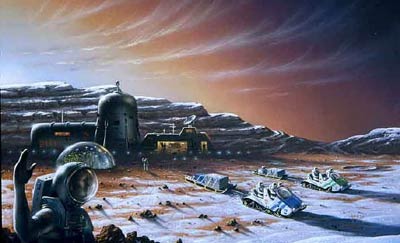Fostering links between space and the environmentby Charles Cockell and Douglas M. Messier
|
| The Foundation is dedicated to the vision of Earth as an oasis tended to by a spacefaring civilization. |
Annual grants support work in three broad categories: the study of Earth to help us understand conditions on other worlds; the use of space technologies to help us preserve the Earth’s unique environment; and educational field trips that inform the public about the links between space and the environment.
In the first category, the grants have supported research in astrobiology, exobiology and extraterrestrial analog environments on Earth. The Foundation has helped to fund the NASA Haughton-Mars Project in the Canadian Arctic. Each summer, scientists work at the site to better understand what conditions might be like on the Red Planet.
The Foundation also provided a grant to an international caving expedition to study the psychology of explorers subjected to long-term isolation in caves in Mexico. NASA’s Johnson Space Center used the results of psychometric tests on the cavers to improve US astronaut selection criteria.
In 2001, the Foundation helped to fund an Antarctic expedition led by Brian Duval on behalf of the Massachusetts Department of Environmental Protection. This expedition studied snow algae, which is an analog to possible forms of life in extraterrestrial snow- and ice-covered environments.
Annual grants have funded a number of expeditions that have used remote sensing and GPS to preserve endangered regions of the planet. In 2001, the Foundation provided Edinburgh University in Scotland with a grant to use GPS systems to map completely new and uncharacterized coral reefs in Madagascar. The study is part of an ongoing effort by the university’s Coral Awareness program to study new coral reefs to understand the extent of their biological importance to local ecosystems and ocean health.
The Foundation also assisted the West African Rice Development Association in its efforts to use satellite remote sensing to map and characterize flood plains in the region. The remote sensing data were coupled with ground-truth and low-flight information to build up maps of this vital food production region that are now being used to improve rice production and harvesting.
Annual grants also fund educational fieldtrips that improve public understanding of the links between environmental and space exploration. In 1999, the Foundation provided a grant to Kevin Hand from the NASA Ames Research Center to assist in his travels across Africa to talk to schools about space research and education.
| Society faces the dual challenge of preserving the Earth’s environment and expanding out into space. Success in either requires boldly advancing on both. |
His trip led to the formation of Cosmos Education, a new US-based non-profit dedicated to space education in developing countries. The Cosmos Education Foundation, by organizing the “Under African Skies” conference, has helped African children to understand how space research can be of direct benefit to their lives and their welfare.
The Foundation has one funding round each year. The deadline for applications is April 30. More information is available on the Foundation’s web site at www.earthandspace.org.
Long-term expedition awards
The Foundation has established a series of awards for the future human exploration of the Moon and Mars. The awards, funded through a separate endowment, will honor the following human firsts on other worlds:
- Undertaking an overland expedition to the Martian South Pole
- Undertaking an overland expedition to the Martian North Pole
- Climbing Olympus Mons, the highest mountain in the solar system
- Descending to the bottom of Valles Marineris, the deepest canyon on Mars
- Circumnavigating the Moon at its equator.
These awards help to build a link between the past exploration on Earth and the future conquest of other worlds.
Art collection
The Foundation’s other long-range effort involves acquiring a collect of paintings and drawings that depict epic human expeditions on the space frontier. The Foundation holds the original of the 1993 Pat Rawlings painting, “Hard Science,” that depicts a suited explorer climbing the foothills of Olympus Mons. In 2000, it commissioned a painting of explorers setting out for the Martian North Pole titled, “Farewell! Departure for the Pole!” The Foundation also holds two paintings by Michael Carroll depicting explorers at the Martian North Pole.
These paintings are not only long-term assets, but they depict in visual form the expeditions and field research the Foundation will one day fund. They directly depict the common spirit that links the exploration of Earth and space.
Conclusion
Society faces the dual challenge of preserving the Earth’s environment and expanding out into space. Both are essential to our quality of life and humanity’s future. Neither goal can exclude the other; success in either requires boldly advancing on both. The Foundation is committed to helping humanity reach a future in which the Earth is an oasis tended to by a spacefaring civilization.
The foundation is support through donations, which are tax deductible in the United States and the United Kingdom. For more information, please visit the foundation’s web site.
